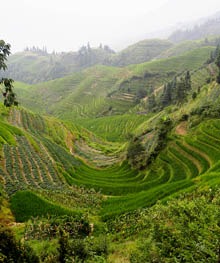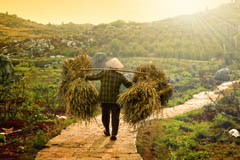The statistics are startling. The People’s Republic of China (PRC) constitutes 22 percent of the world’s population but only 7 percent of the world’s arable land. And 50 percent of that area has been severely eroded. Desertification is occurring in almost 30 percent of China and salinization affects 10 percent of the nation.
It is tempting to conclude that this situation has come about simply because of population pressure, but there are many other countries in the world with even higher population densities that don’t have the same problem. Rather, the resource degradation phenomena, particularly in western China, has come about through the imposition of a raft of policies beginning in 1949 with the Mao regime.
The requirement for grain self-sufficiency in each province pushed ill-suited lands into unsustainable agricultural production. This was exacerbated by an industrialization policy that located factories in the less populated and strategically secure western provinces, and an associated policy of forcibly moving people into the hinterland
Collectivism at Work
Most significantly, agriculture was collectivized. State ownership of the land and the products of the land, right through to state monopoly control of the distribution process, meant that individual farmers had no financial incentive to be productive. Nor did they have an incentive to care about the condition of the natural resources—the soil and water—which were once central to the sustainability of their livelihoods.
Even the introduction of the Household Responsibility System (HRS) in 1978, which served as a key component to economic reform, was not able to stem the tide of resource degradation. Under the HRS, farmers were given rights to the products of their labor. These so-called “use rights” did not, however, extend farmers’ incentives to care for the natural resources they used. These incentives were further weakened by frequent compulsory seizure of land without compensation.
The degradation of China’s agricultural lands— particularly those in the western provinces with their fragile soils and harsh climate—presents a multitude of issues. Environmentally, the rivers are choked with silt, the air is polluted by sand storms on top of motor vehicle exhausts and factory wastes, plants and animals are being pushed to extinction, and the western landscape has taken on a lunar quality. Socially, the livelihoods of millions of farming families are being jeopardized by diminishing productivity and an increasing frequency of natural disasters such as floods and mud slides. Politically, the pressure of dissatisfied, poor, rural households seeking to relocate to wealthier urban areas is unnerving to the Central Council of the PRC.
Grain for Green
In recognition of these issues, in 1999 the Chinese Government instituted the Conversion of Cropland to Forest and Grassland Program (CCFGP) in an attempt to stabilize the soils of highly erodable areas. Under the program—often called the Grain for Green Program—farmers are paid a combination of cash and grain to plant tree seedlings or perennial grasses (provided free) on previously cropped or barren land.
The program has been enthusiastically embraced by more than 15 million farm households across 25 provinces. Between 1999 and 2005, 55 million acres were converted. The Chinese government has budgeted US$43.6 billion for CCFGP and it is expected to increase forest and grassland areas by 93 million acres by 2010.
A chief concern regarding the program is whether the land-use changes it has generated will be continued once the payments of grain and cash are stopped. For farmers to refrain from simply returning to their previous practices, the net income stream resulting from the newly established trees (from fruit and lumber production) and grass (from grazing enterprises) must be greater than the old patterns of annual cropping.
Under the Grain for Green program, farmers are paid a combination of cash and grain to plant tree seedlings or perennial grasses.
Surveys of farmers across four provinces in northwest China, reported in Environmental Protection in China: Land Use Management (2008), show that, in general, the profitability of the new land uses over a ten-year time frame, including tree crops (apples, apricots, and persimmons) and perennial pastures for tethered livestock, is superior to those generated by the continuation of old practices such as annual cropping of wheat and unconstrained grazing.
This result is good news for the sustainability of the program’s land use changes and the continuation of the environmental and social benefits they bring. However, it begs the question: If the alternative land uses offered better livelihoods, why didn’t farmers adopt the changes without the need for the CCFGP?
Piecing the Puzzle
The answer to this question is multifaceted. Undoubtedly, a lack of knowledge regarding the alternatives promoted the continuation of the status quo. Also, the costs of change—including the costs of tree seedlings and pasture seed as well as the years of foregone income during the establishment phase of tree crops and grazing enterprises—presented a barrier to many farmers without personal savings or access to credit.
Another important element of the answer relates to the weak definition and defense of the property rights held by farmers. Without clearly defined and defended rights to the land, farmers are constantly concerned that they will lose their access. Farmers can limit the risk this presents to their livelihood by reducing the time period between the planting effort and the harvest reward. Annual cropping is therefore a low-risk option compared to establishing pastures for grazing and, even more so, the planting of tree crops. A crop of wheat, for example, takes just one season to provide an income, but an apricot or an apple tree will not bear a financially rewarding crop for at least three years. Chinese farmers know that a lot can happen, politically, in three years that may cause them to lose access to the trees they planted.
What the CCFGP did for farmers was to provide an assured source of annual income in the period when the new land uses were being established and before they could yield readily accessible annual income streams. In essence, the program lowered the risks of land use change created by the insecure property rights.
The message relating to property rights has not been lost on the Chinese government. One component of the CCFGP has been an extension to 70 years of the use rights farmers have over their outputs if they enroll in the program. In 2007, the annual meeting of the Central Council discussed the prospect of instituting private property rights over more intensively used agricultural land. Should this occur, the extent of the government’s budgetary commitment to the continuation of the CCFGP, and numerous other resource protection schemes (including the Shelterbelt Development Program and the Sand Control Program for Beijing and Tianjin) could be reduced while more environmental protection is being achieved.
NOTE: This article is based on a project Bennett has been leading with the Chinese Forest Economics and Development Research Centre, with funding from the Australian Centre for International Agricultural Research. More details of the project can be found in Bennett, Wang and Zhang, Environmental Protection in China: Land Use Management (2008).




